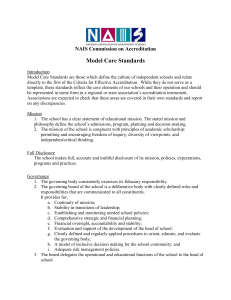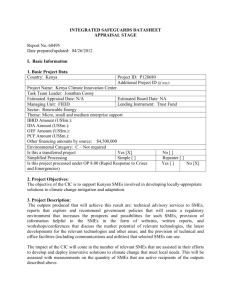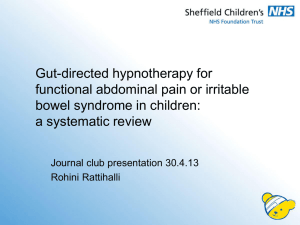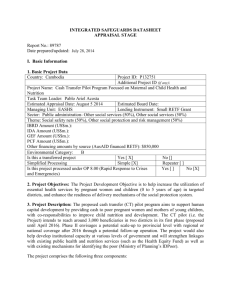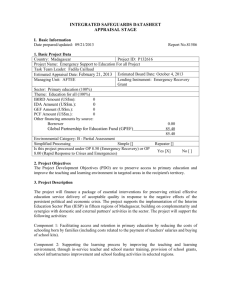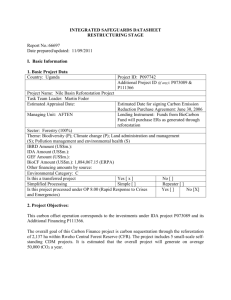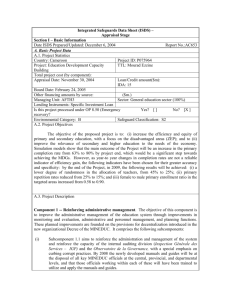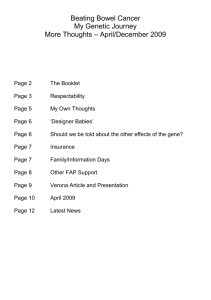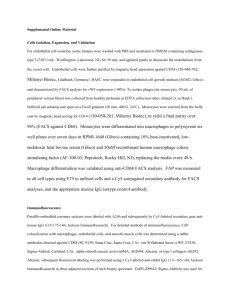integrated safeguards datasheet - Documents & Reports
advertisement
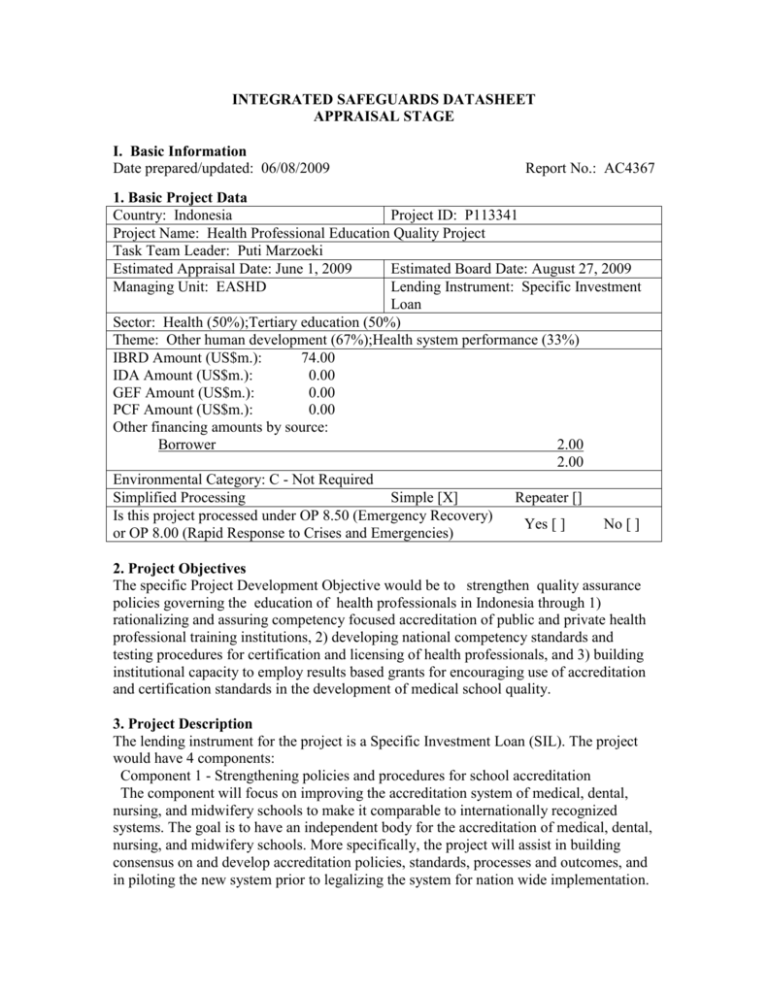
INTEGRATED SAFEGUARDS DATASHEET APPRAISAL STAGE I. Basic Information Date prepared/updated: 06/08/2009 Report No.: AC4367 1. Basic Project Data Country: Indonesia Project ID: P113341 Project Name: Health Professional Education Quality Project Task Team Leader: Puti Marzoeki Estimated Appraisal Date: June 1, 2009 Estimated Board Date: August 27, 2009 Managing Unit: EASHD Lending Instrument: Specific Investment Loan Sector: Health (50%);Tertiary education (50%) Theme: Other human development (67%);Health system performance (33%) IBRD Amount (US$m.): 74.00 IDA Amount (US$m.): 0.00 GEF Amount (US$m.): 0.00 PCF Amount (US$m.): 0.00 Other financing amounts by source: Borrower 2.00 2.00 Environmental Category: C - Not Required Simplified Processing Simple [X] Repeater [] Is this project processed under OP 8.50 (Emergency Recovery) Yes [ ] No [ ] or OP 8.00 (Rapid Response to Crises and Emergencies) 2. Project Objectives The specific Project Development Objective would be to strengthen quality assurance policies governing the education of health professionals in Indonesia through 1) rationalizing and assuring competency focused accreditation of public and private health professional training institutions, 2) developing national competency standards and testing procedures for certification and licensing of health professionals, and 3) building institutional capacity to employ results based grants for encouraging use of accreditation and certification standards in the development of medical school quality. 3. Project Description The lending instrument for the project is a Specific Investment Loan (SIL). The project would have 4 components: Component 1 - Strengthening policies and procedures for school accreditation The component will focus on improving the accreditation system of medical, dental, nursing, and midwifery schools to make it comparable to internationally recognized systems. The goal is to have an independent body for the accreditation of medical, dental, nursing, and midwifery schools. More specifically, the project will assist in building consensus on and develop accreditation policies, standards, processes and outcomes, and in piloting the new system prior to legalizing the system for nation wide implementation. This includes developing an accreditation strategic framework, accreditation instruments, assessor recruitment system and training, and a policy mandating publication of accreditation results for easy access by the general public. The project will revitalize the function of the National Medical Education Research Center initiated under the World Bank financed HWS Project and support the DGHE in synchronizing data collection and analysis for accreditation and EPSBED,(Evaluation of Study Programs Based on SelfEvaluation), a tool designed by DGHE to monitor HEI statistics. This will help the self evaluation prior to the accreditation process and will inform decision making and planning processes in the institutions. Project resources would be used for the costs of workshops and training, benchmarking, international and local technical assistance, legal assistance studies and surveys, office equipment, IT and audio visual equipment and furniture. Component 2 - Certification of graduates using national competency-based examination The purpose of certification is to assure the standard of education quality. The project will support the establishment of an independent National Evaluation Center responsible for developing, validating and implementing strategies, methodologies, and tools to evaluate the competence of medical, dental, nursing and midwifery students prior to graduation from the respective education institutions. The challenge is to develop an evaluation mechanism measuring not only knowledge but also clinical skills, attitude, ethics, and communication skills; and to develop policies introducing discipline in determining passing scores and transparent remedial examination for failing students. In this regard, the project will assist the National Evaluation Center in establishing Computer Based Testing (CBT) and Objective Structured Clinical Evaluation (OSCE) facilities in 12 medical education institutions that will function as regional centers. To improve the validity and reliability of the examination, the project would assist the establishment of an item bank networking system. The system would also allow Health HEIs to evaluate their teaching methods. Expenditures include IT and audiovisual equipment, computer software, skills laboratory equipment, office equipment, furniture, international and local technical assistance, international benchmarking, workshop and training. Component 3 - Results based financial assistance package (FAP) Building on the agreements on accreditation and certification, the project would allocate financial assistance packages (FAP) for selected medical education institutions (MEIs) to meet the accreditation standards. The project would adopt 3 key principles in allocating the FAPs: (i) results based allocation of resources, (ii) fair competition among MEIs according to their capacity, and (iii) partnership between leading and less strong NEIs to build the capacity of the less strong schools according to their specific needs. The project would have 3 FAP schemes: - Scheme A: FAP for leading medical education institutions to build their international reputation and to strengthen Indonesia’s global competitiveness. - Scheme B: FAP to support weak capacity and new medical education institutions in achieving medical education standards mandated by the Indonesia Medical Council (IMC) through partnership with a leading medical education institution, - Scheme C: FAP to support moderate capacity medical education institutions in achieving medical education standards mandated by the IMC The Board of Higher Education (BHE) is responsible for establishing the guidelines for the FAP recipient selection and proposal approval process and for overseeing the FAP implementation. A FAP manual would be prepared by the BHE to guide the implementation of the FAP. The BHE established the criteria for grouping existing MEIs into 4 categories: leading, moderate, weak, and new MEIs. Applying the criteria, the 69 existing MEIs are grouped into 10 leading, 18 moderate, 14 weak and 27 new MEIs (see Annex xx for details). There would only be one selection process during the life time of the project to be conducted immediately after project effectiveness. Each FAP recipient would implement the program in 4 years. Component 4 – Project Management A Central Project Coordination Unit (CPCU) would be established at the DGHE. Project resources would finance the cost of staff honoraria, project management consultant, office equipment, furniture and project monitoring and evaluation. 4. Project Location and salient physical characteristics relevant to the safeguard analysis Component 1, 2, and 4 will be implemented in Jakarta. Component 3 will be implemented in medical schools in Indonesia selected to get the Financial Assistance Package. 5. Environmental and Social Safeguards Specialists Ms Francisca Melia Setiawati (EASIS) Mr Andrew Daniel Sembel (EASIS) 6. Safeguard Policies Triggered Environmental Assessment (OP/BP 4.01) Natural Habitats (OP/BP 4.04) Forests (OP/BP 4.36) Pest Management (OP 4.09) Physical Cultural Resources (OP/BP 4.11) Indigenous Peoples (OP/BP 4.10) Involuntary Resettlement (OP/BP 4.12) Safety of Dams (OP/BP 4.37) Projects on International Waterways (OP/BP 7.50) Projects in Disputed Areas (OP/BP 7.60) Yes No X X X X X X X X X X II. Key Safeguard Policy Issues and Their Management A. Summary of Key Safeguard Issues 1. Describe any safeguard issues and impacts associated with the proposed project. Identify and describe any potential large scale, significant and/or irreversible impacts: The project does not affect communities of indigenous peoples and thus the IP Policies are not triggered. The project will provide Financial Assistance Package (FAP) to selected medical schools, and an eligible spending under the FAP is providing access of the poor to medical education through a scholarship program. The medical schools will not actively seek scholarship candidates from the poor community. This is consistent with the Government policy of promoting access of underprivileged students to higher education Limited civil work is an eligible expenditure under Scheme B1, B2 and C of the FAP, but any civil work undertaken through the FAP program in the project is limited to the rehabilitation of existing lecture rooms and laboratories. The FAP manual states this provision and the manual would be used as reference not only by the medical schools in preparing the proposal but also by the reviewer of the FAP proposals. 2. Describe any potential indirect and/or long term impacts due to anticipated future activities in the project area: No potential indirect and/or long term impacts are expected 3. Describe any project alternatives (if relevant) considered to help avoid or minimize adverse impacts. N/A 4. Describe measures taken by the borrower to address safeguard policy issues. Provide an assessment of borrower capacity to plan and implement the measures described. N/A 5. Identify the key stakeholders and describe the mechanisms for consultation and disclosure on safeguard policies, with an emphasis on potentially affected people. N/A B. Disclosure Requirements Date Environmental Assessment/Audit/Management Plan/Other: Was the document disclosed prior to appraisal? Date of receipt by the Bank Date of "in-country" disclosure Date of submission to InfoShop For category A projects, date of distributing the Executive Summary of the EA to the Executive Directors Resettlement Action Plan/Framework/Policy Process: Was the document disclosed prior to appraisal? Date of receipt by the Bank Date of "in-country" disclosure Date of submission to InfoShop Indigenous Peoples Plan/Planning Framework: Was the document disclosed prior to appraisal? Date of receipt by the Bank Date of "in-country" disclosure Date of submission to InfoShop Pest Management Plan: Was the document disclosed prior to appraisal? Date of receipt by the Bank Date of "in-country" disclosure Date of submission to InfoShop * If the project triggers the Pest Management and/or Physical Cultural Resources, the respective issues are to be addressed and disclosed as part of the Environmental Assessment/Audit/or EMP. If in-country disclosure of any of the above documents is not expected, please explain why: N/A C. Compliance Monitoring Indicators at the Corporate Level (to be filled in when the ISDS is finalized by the project decision meeting) The World Bank Policy on Disclosure of Information Have relevant safeguard policies documents been sent to the World Bank's Infoshop? Have relevant documents been disclosed in-country in a public place in a form and language that are understandable and accessible to project-affected groups and local NGOs? All Safeguard Policies Have satisfactory calendar, budget and clear institutional responsibilities been prepared for the implementation of measures related to safeguard policies? Have costs related to safeguard policy measures been included in the project cost? Does the Monitoring and Evaluation system of the project include the monitoring of safeguard impacts and measures related to safeguard policies? Have satisfactory implementation arrangements been agreed with the borrower and the same been adequately reflected in the project legal documents? N/A N/A N/A N/A N/A N/A D. Approvals Signed and submitted by: Task Team Leader: Environmental Specialist: Social Development Specialist Additional Environmental and/or Social Development Specialist(s): Name Date Ms Puti Marzoeki Mr Virza S. Sasmitawidjaja Mr Jose Vicente Zevallos 06/01/2009 05/19/2006 05/20/2006 Mr Juan Pablo Uribe 06/05/2009 Approved by: Sector Manager: Comments:
